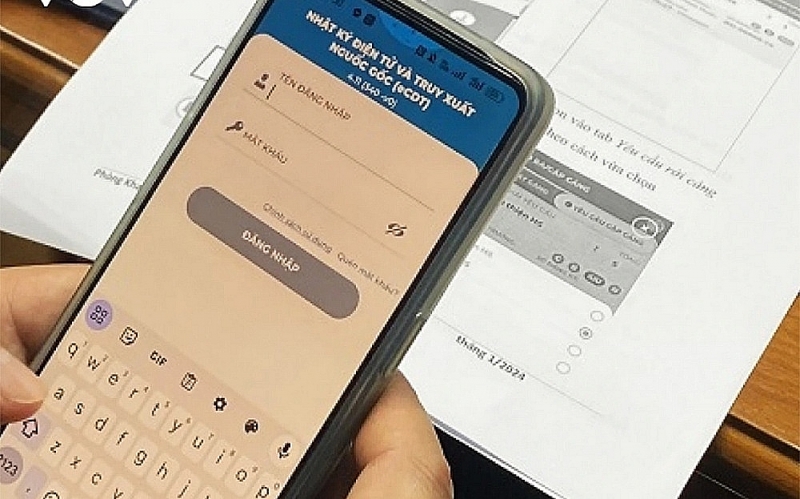New step in tracing seafood origin, meeting export requirements
Using the electronic seafood traceability application (eCDT VN) will help seafood exporting enterprises more conveniently apply for export product traceability documents (SC, CC). This will help the Vietnamese seafood industry better adapt to the trend of international integration and the demand for transparency in seafood origin of the export market.
Being more convenient for seafood processing and exporting enterprises
According to the Department of Fisheries (Ministry of Agriculture and Rural Development), the electronic seafood traceability system (eCDT VN application) was deployed from January 2024. This application can help fishermen conveniently complete the procedures for quick entry and exit, without having to bring a lot of documents when completing the procedures, even without having to go to the port, and will eventually replace the paper fishing log.
 |
|
Seafood exporting enterprises will have great convenience in applying for documents on traceability of exported products (SC, CC) thanks to eCDT. |
For management agencies such as the Fishing Port Management Board and the Fisheries Sub-Department, the application helps monitor the output at the wharf in conditions of limited resources; increase the level of reliability and transparency, eliminate errors in the process of monitoring fishing vessels, monitoring output, issuing certificates of exploited raw aquatic products, etc when the information is available on the system.
As for seafood exporting enterprises, it will be very convenient to apply for documents to trace the origin of exported products (SC, CC).
Opening the application for SC, CC on the system is convenient, fast and accurate, avoiding common errors when doing it on paper, and enterprises do not even need to go to the fishing port or the Fisheries Sub-Department to carry out the procedures as they do now.
Monitoring output and tracing the origin of aquatic products from exploitation
A number of provinces have also simultaneously organized the implementation of the system, in which many provinces are leading in implementation results such as Binh Dinh, Binh Thuan, Ca Mau, Da Nang, Khanh Hoa.
According to Mr. Phan Ngoc Tan, Deputy Head of the Department of Fisheries of Khanh Hoa province, since February 25, 2024, fishing vessels entering and leaving ports at fishing ports in the province have applied the eCDT software. Up to now, management agencies have carried out the prescribed procedures through this software for 3,289 departures and 2,894 arrivals.
Deploying the issuance of 762 receipts for unloading aquatic products through ports, issuing 67 confirmations of exploited aquatic products and 2 certificates of exploited aquatic products on the eCDT system.
In addition, 197 accounts have been registered to open on the eCDT system for state management agencies, enterprises, seafood purchasing and processing establishments; instructions on installing the eCDT application for hundreds of fishing vessel owners in the province, etc.
In the coming time, Khanh Hoa province will implement 100% of all activities of confirming the departure and arrival of fishing vessels; Control statistical output through fishing ports; issue receipts for unloading aquatic products through ports; issue confirmation of exploited aquatic materials and certification of exploited aquatic products on the eCDT system.
 |
|
Electronic traceability of seafood will overcome shortcomings and limitations in traceability according to the recommendations of the European Commission (EC). Illustration photo: Nguyen Hien |
The electronic traceability system (eCDT) is the first software built on the basis of a new approach to state management in the field of fisheries exploitation to suit the trend of international integration and the requirements for transparency in the origin of aquatic products set by export markets.
Thereby helping state management agencies effectively manage the fleet and landing output of each locality, even when those vessels dock and unload at ports in other localities.
The implementation of the "Electronic Seafood Traceability System" is an important step in the effort to remove the "Yellow Card" warning of the European Commission (EC) and improve the efficiency of fisheries management. This is considered a trend of digital transformation in the fisheries sector today.
However, the implementation process still faces some difficulties and limitations, such as the system implementation is slow and asynchronous; The newly deployed software initially caused confusion and difficulties for fishermen when they first approached the application and operated it on their phones, etc.
To deploy the System effectively, in the entire chain and synchronously across the country, according to the leader of the Department of Fisheries, it is necessary to supplement legal mechanisms, provide synchronous direction in localities, upgrade information technology infrastructure at fishing ports and system features, strengthen training and communication, as well as have strict measures to handle organizations and individuals who do not comply with regulations.
The report of the Department of Fisheries on the results of implementing the electronic traceability system shows that, as of October 22, 2024, 26/28 provinces have implemented the eCDT system with 80 fishing ports and fish landing points. Exports have been carried out for 59,978 ships leaving the port and 49,113 ships arriving at the port on the eCDT system; 3,053 receipts for unloading products through the port have been issued; 318 SCs and 49 CCs have been issued on the eCDT system.
In addition, the Department of Fisheries has issued accounts to 5 participants in the system related to the chain of exploitation - processing - export of aquatic products. Specifically, all fishing vessels nationwide (80,646 accounts), 28 Fisheries Sub-Departments of coastal provinces and cities with 147 accounts; 172 border guard station accounts along 28 coastal provinces and cities and 117 seafood processing and export enterprises.








